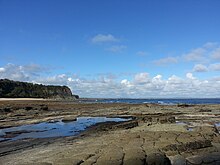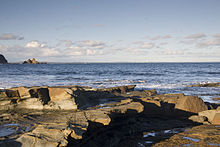| Bunurong Marine National Park Victoria | |
|---|---|
IUCN category II (
national park) | |
 A cliff at
Cape Paterson, located adjacent to the marine park. | |
| Nearest town or city | Cape Paterson |
| Coordinates | 38°41′28″S 145°39′22″E / 38.69111°S 145.65611°E |
| Established | 16 November 2002 [1] |
| Area | 21 km2 (8.1 sq mi) [1] |
| Visitation | circa 250,000 (in 2005) [1] |
| Managing authorities | Parks Victoria |
| Website | Bunurong Marine National Park |
| See also | Protected areas of Victoria |
The Bunurong Marine National Park ( /ˈbʌnərɒŋ/) is a protected marine national park located off the coast of Cape Paterson in the South Gippsland region of Victoria, Australia. The 2,100-hectare (5,200-acre) marine national park is located about 6 kilometres (3.7 mi) southwest of Inverloch and about 5 kilometres (3.1 mi) off the coastline. The coastal waters protect a range of habitats including intertidal reefs, subtidal rocky reefs, algal gardens and seagrass beds. The waters are cool, akin to Victoria’s central and western coasts. However, they are relatively protected from south-westerly swells due to the location of far away King Island, Tasmania. [2]
The Bunurong Marine National Park is an outstretching middle section of the Bunurong Marine Park. Both parks draw their name from the Australian Aboriginal Bunurong people who are the traditional owners of the land and water in the region. [2]
Etymology


The Bunurong parks are named after the Bunurong Aboriginal people whom were custodians of this stretch of coast for thousands of years prior to white settlement. The Boakoolawal clan lived in the Kilcunda area south of the Bass River, and the Yowenjerre were west of the Tarwin River along what is now the Bunurong Marine and Coastal Parks near Wonthaggi. Middens containing charcoal and shellfish mark the location of their campsites along the coast. [3]
Features
The principal features of the park are the striking rock formations including the large rock structure called Eagles Nest, located adjacent to the coastline at the eastern end of the marine national park. Eagles Nest also resembles the top half of a map of Australia. [4] [5] Other attractions include Flat Rocks where there are large rockpools for rockpool rambling and direct access from Cape Paterson-Inverloch Road. The Bunurong Marine National Park is accessed at many different points along this coast, a popular one being near Cape Paterson caravan park on Surf Beach Road as it has a modified rockpool for swimming. [6] Direct and more difficult access to the marine national park is via car parks off Cape Paterson-Inverloch Road. Exploring, snorkelling [7] and scuba diving are popular. There are boat launching facilities at Inverloch on Anderson Inlet. [2]
Australia’s first dinosaur bone, the Cape Paterson Claw, was discovered in 1903 by William Ferguson at what is now Bunurong Marine Park at Eagles Nest beach in Inverloch. Since then more than 6,000 bones and teeth of small dinosaurs, mammals, birds, turtles and fish have been excavated. [2] There is a dinosaur exhibition at the Inverloch Shell Museum. [8]
Ecology
Together with the Bunurong Marine Park, the Bunurong Marine National Park supports many marine animals including seastars, featherstars, crabs, snails, 87 species of fish, whales and seals. It has the highest recorded diversity of intertidal and subtidal invertebrates in eastern Victoria. The range of seaweed species is large. [9]
Restrictions
It is prohibited to kill or take any matter (i.e., catch fish, collect seashells or kill or take any sea or land creature, living or dead) from the Bunurong Marine National Park, but fishing (only with a rod) is permitted in the Bunurong Marine Park, which is located adjacent to the marine national park. [10]
See also
References
- ^
a
b
c
Bunurong Marine National Park Management Plan (PDF) (PDF). Government of Victoria. July 2006.
ISBN
0-7311-8355-X. Retrieved 29 August 2014.
{{ cite book}}:|work=ignored ( help) - ^ a b c d "Bunurong Marine National Park". Parks Victoria. Government of Victoria. 2014. Retrieved 29 August 2014.
- ^ "Bunurong Marine Park". Bass Coast Tourism. Retrieved 13 November 2013.
- ^ "Bunurong Marine National Park: Marine Natural Values Study Summary" (PDF). Parks Victoria and Deakin University (PDF). Government of Victoria. 2014. Retrieved 29 August 2014.
- ^ "Coastal in Cape Paterson". Film Gippsland. Archived from the original on 28 February 2011. Retrieved 14 November 2013.
- ^ "About". Cape Paterson Caravan Park. 2014. Retrieved 14 November 2013.
- ^ "Bunurong Marine Park". South Gippsland. South Gippsland Web Design. 2014. Retrieved 13 November 2013.
- ^ "Dinosaur Dreaming". Museum Victoria. 7 September 2008. Archived from the original on 3 September 2014. Retrieved 14 November 2013.
- ^ "Wonthaggi Information". Please take me to. Archived from the original on 31 December 2010. Retrieved 14 November 2013.
- ^ "Restricted Areas - Marine National Parks". Department Of Environment and Primary Industries. Government of Victoria. 28 January 2014. Retrieved 29 August 2014.
External links
- Ferns, Lawrance W.; Hough, Don, eds. (February 2002).
High Resolution Marine Habitat Mapping of the Bunurong Coast (Victoria) – Including the Bunurong Marine and Coastal Park (PDF) (PDF). Government of Victoria.
{{ cite book}}:|work=ignored ( help) - "Marine National Parks and Marine Sanctuaries Boundary Coordinates" (PDF). Parks Victoria (PDF). Government of Victoria. July 2013. p. 30. Archived from the original (PDF) on 3 March 2014. Retrieved 29 August 2014.
- "Bass Coast Parks and Reserves: Visitor Guide" (PDF). Parks Victoria (PDF). Government of Victoria. August 2012.
- "Enjoying the Bunurong Coast: Visitor Guide" (PDF). Parks Victoria (PDF). Government of Victoria. September 2012.
| Bunurong Marine National Park Victoria | |
|---|---|
IUCN category II (
national park) | |
 A cliff at
Cape Paterson, located adjacent to the marine park. | |
| Nearest town or city | Cape Paterson |
| Coordinates | 38°41′28″S 145°39′22″E / 38.69111°S 145.65611°E |
| Established | 16 November 2002 [1] |
| Area | 21 km2 (8.1 sq mi) [1] |
| Visitation | circa 250,000 (in 2005) [1] |
| Managing authorities | Parks Victoria |
| Website | Bunurong Marine National Park |
| See also | Protected areas of Victoria |
The Bunurong Marine National Park ( /ˈbʌnərɒŋ/) is a protected marine national park located off the coast of Cape Paterson in the South Gippsland region of Victoria, Australia. The 2,100-hectare (5,200-acre) marine national park is located about 6 kilometres (3.7 mi) southwest of Inverloch and about 5 kilometres (3.1 mi) off the coastline. The coastal waters protect a range of habitats including intertidal reefs, subtidal rocky reefs, algal gardens and seagrass beds. The waters are cool, akin to Victoria’s central and western coasts. However, they are relatively protected from south-westerly swells due to the location of far away King Island, Tasmania. [2]
The Bunurong Marine National Park is an outstretching middle section of the Bunurong Marine Park. Both parks draw their name from the Australian Aboriginal Bunurong people who are the traditional owners of the land and water in the region. [2]
Etymology


The Bunurong parks are named after the Bunurong Aboriginal people whom were custodians of this stretch of coast for thousands of years prior to white settlement. The Boakoolawal clan lived in the Kilcunda area south of the Bass River, and the Yowenjerre were west of the Tarwin River along what is now the Bunurong Marine and Coastal Parks near Wonthaggi. Middens containing charcoal and shellfish mark the location of their campsites along the coast. [3]
Features
The principal features of the park are the striking rock formations including the large rock structure called Eagles Nest, located adjacent to the coastline at the eastern end of the marine national park. Eagles Nest also resembles the top half of a map of Australia. [4] [5] Other attractions include Flat Rocks where there are large rockpools for rockpool rambling and direct access from Cape Paterson-Inverloch Road. The Bunurong Marine National Park is accessed at many different points along this coast, a popular one being near Cape Paterson caravan park on Surf Beach Road as it has a modified rockpool for swimming. [6] Direct and more difficult access to the marine national park is via car parks off Cape Paterson-Inverloch Road. Exploring, snorkelling [7] and scuba diving are popular. There are boat launching facilities at Inverloch on Anderson Inlet. [2]
Australia’s first dinosaur bone, the Cape Paterson Claw, was discovered in 1903 by William Ferguson at what is now Bunurong Marine Park at Eagles Nest beach in Inverloch. Since then more than 6,000 bones and teeth of small dinosaurs, mammals, birds, turtles and fish have been excavated. [2] There is a dinosaur exhibition at the Inverloch Shell Museum. [8]
Ecology
Together with the Bunurong Marine Park, the Bunurong Marine National Park supports many marine animals including seastars, featherstars, crabs, snails, 87 species of fish, whales and seals. It has the highest recorded diversity of intertidal and subtidal invertebrates in eastern Victoria. The range of seaweed species is large. [9]
Restrictions
It is prohibited to kill or take any matter (i.e., catch fish, collect seashells or kill or take any sea or land creature, living or dead) from the Bunurong Marine National Park, but fishing (only with a rod) is permitted in the Bunurong Marine Park, which is located adjacent to the marine national park. [10]
See also
References
- ^
a
b
c
Bunurong Marine National Park Management Plan (PDF) (PDF). Government of Victoria. July 2006.
ISBN
0-7311-8355-X. Retrieved 29 August 2014.
{{ cite book}}:|work=ignored ( help) - ^ a b c d "Bunurong Marine National Park". Parks Victoria. Government of Victoria. 2014. Retrieved 29 August 2014.
- ^ "Bunurong Marine Park". Bass Coast Tourism. Retrieved 13 November 2013.
- ^ "Bunurong Marine National Park: Marine Natural Values Study Summary" (PDF). Parks Victoria and Deakin University (PDF). Government of Victoria. 2014. Retrieved 29 August 2014.
- ^ "Coastal in Cape Paterson". Film Gippsland. Archived from the original on 28 February 2011. Retrieved 14 November 2013.
- ^ "About". Cape Paterson Caravan Park. 2014. Retrieved 14 November 2013.
- ^ "Bunurong Marine Park". South Gippsland. South Gippsland Web Design. 2014. Retrieved 13 November 2013.
- ^ "Dinosaur Dreaming". Museum Victoria. 7 September 2008. Archived from the original on 3 September 2014. Retrieved 14 November 2013.
- ^ "Wonthaggi Information". Please take me to. Archived from the original on 31 December 2010. Retrieved 14 November 2013.
- ^ "Restricted Areas - Marine National Parks". Department Of Environment and Primary Industries. Government of Victoria. 28 January 2014. Retrieved 29 August 2014.
External links
- Ferns, Lawrance W.; Hough, Don, eds. (February 2002).
High Resolution Marine Habitat Mapping of the Bunurong Coast (Victoria) – Including the Bunurong Marine and Coastal Park (PDF) (PDF). Government of Victoria.
{{ cite book}}:|work=ignored ( help) - "Marine National Parks and Marine Sanctuaries Boundary Coordinates" (PDF). Parks Victoria (PDF). Government of Victoria. July 2013. p. 30. Archived from the original (PDF) on 3 March 2014. Retrieved 29 August 2014.
- "Bass Coast Parks and Reserves: Visitor Guide" (PDF). Parks Victoria (PDF). Government of Victoria. August 2012.
- "Enjoying the Bunurong Coast: Visitor Guide" (PDF). Parks Victoria (PDF). Government of Victoria. September 2012.
